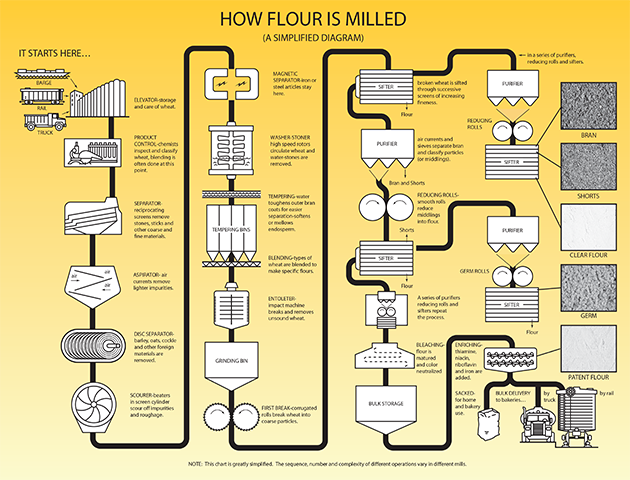Generic Product Specifications

Types of flour according to use:
White flours
There are several types of flour, prepared by finely grinding the endosperm (inner portion) of wheat grain after the bran (outer coat) and the germ (seed embryo) have been removed.
1. All Purpose, top patent, general purpose, or family flours are usually a blend of hard spring wheats that are lower in protein content than bread flours. They are top patent flours and contain sufficient protein to make good yeast breads, yet not too much for good quick breads, cakes and cookies.
Protein: typically 10.0 – 12.5% (12.8 – 14.5% dry basis)
Ash: 0.35 – 0.55% (0.41 – 0.64 dry basis)
2. Baker's Patent, 2nd Patent, bread flours are milled from hard spring (red or white) or hard winter wheats. These flours, fairly high in protein and slightly granular to the touch, are sold primarily to commercial bakers because they make excellent bread using commercial bakery equipment, but generally have too much protein (gluten) for home use (difficult to mix and mold by hand). There are two basic types; (a) for the highly mechanized pan bread bakeries and (b) for hearth bread and similar products where extra "dough strength" is needed. These flours are very good for pizza and flat bread applications.
Protein: typically 12.5 – 13.5% (14.5 – 18.2% dry basis)
Ash: 0.50 – 0.60% (0.58 – 0.70% dry basis)
3. Bakers clears, high gluten flour are milled primarily from hard red wheats. These flours are much higher in protein and somewhat darker in colour than standard bread flours. Major uses are for specialty bread production such as rye breads, Italian hearth, crusty rolls and multi-grain breads.
Protein: 13.30-15.00% (15.5-17.4% dry basis)
Ash: 0.65 – 0.85% (0.76 – 0.99% dry basis)
4. Cake flour is milled from soft wheat, winter or spring. The protein content is much lower than hard wheat flours and it produced a flour with granulation so uniform and fine that the flour feels satiny. This flour works especially well in cake formulations, particularly when a high ratio of sugar and fat is present.
Protein: 6.5 – 8.0 % (7.6 – 9.3% dry basis)
Ash: 0.30 – 0.40% (0.35 – 0.47% dry basis)
5. Pastry, 2nd patent, cake and pastry flours are made from soft wheats which are low in protein and are finely milled but not as fine as cake flour. These flours are unsuitable for yeast breads but ideal for lower ratio cakes, pastries, cookies and quick breads.
Protein: 7.5 – 9.5% (8.7 – 11.0% dry basis)
Ash: 0.40 – 0.50% (0.47 – 0.58 % dry basis)
6. Pasta flours (semolina) are granular products consisting of the endosperm of the Durum wheat kernel and containing considerably different gluten characteristics then that of spring wheat. Durum semolina is known for its bright yellow colour.
Protein: typically 12.00 – 13.0% (13.6 - 15.1% dry basis)
Ash: 0.65 – 0.75% (0.76 – 0.87% dry basis)
-
Whole wheat flours
Regular and coarse whole wheat flours, also known as entire wheat flour, are prepared by grinding the entire wheat kernel. Some of these flours that have been historically defined under Canadian food regulations as whole wheat flour may have some of the wheat germ removed during the milling process to enhance shelf life and baking performance. With part of the wheat germ removed, bran and endosperm are blended to constitute approximately 95% or more of the original composition of the wheat kernel.
Canadian wheat millers also produce whole grain wheat flour by grinding the entire wheat berry and preserving the bran and germ in the finished product.
Protein and ash content of whole wheat flours are typically 13.0 – 14.5% (15.1 – 16.9% dry basis) and 1.08 – 1.65% (1.63 – 1.92% dry basis) respectively. Whole grain wheat flours have similar protein and ash content.




